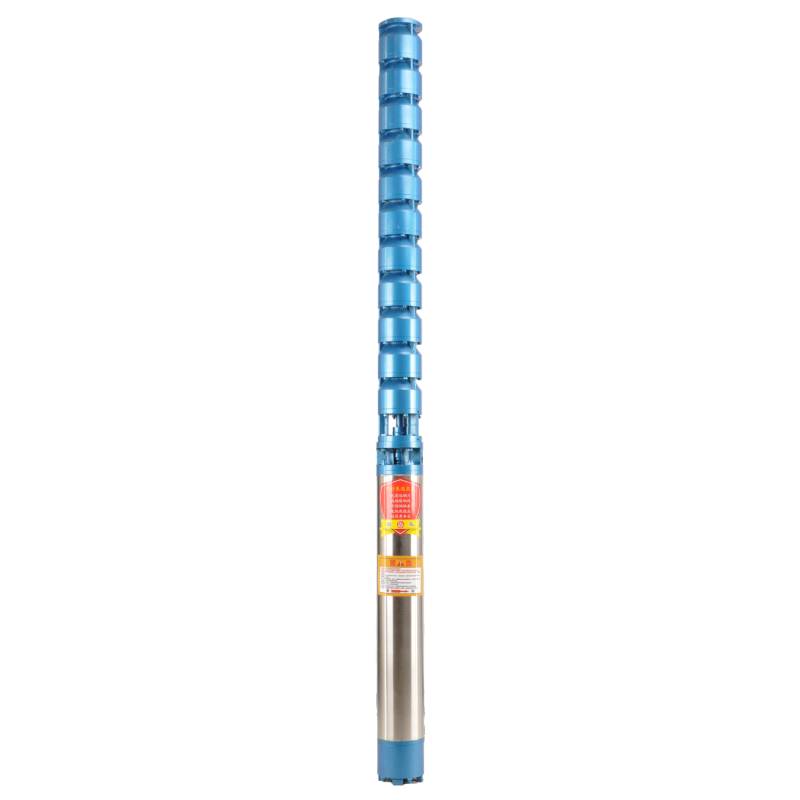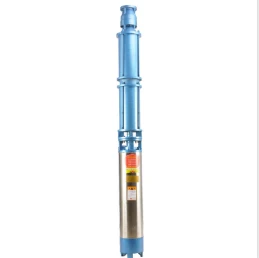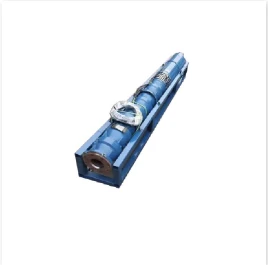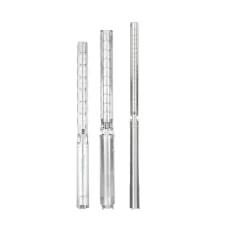Aug . 07, 2025 04:00 Back to list
Reliable 110V Deep Well Submersible Pump for Water Supply
Navigating the Evolving Landscape of Deep Well Pumping Solutions
The global demand for reliable and efficient water supply continues to surge, driven by population growth, expanding agricultural needs, and industrial development. In this context, deep well submersible pumps have emerged as a cornerstone technology for accessing subterranean water resources. Specifically, the **110v deep well submersible pump** represents a crucial segment, offering a versatile and accessible solution for various applications, particularly where higher voltage power grids are unavailable or impractical, such as remote farms, rural homes, or off-grid systems utilizing solar power.
Current industry trends highlight a significant shift towards energy efficiency, smart control systems, and enhanced material durability. The increasing focus on sustainable practices also positions **solar deep well submersible pump** solutions as a rapidly growing sector. The integration of IoT (Internet of Things) capabilities, allowing for remote monitoring and predictive maintenance, is another transformative trend. Manufacturers are continuously innovating to reduce operational costs, extend pump lifespan, and minimize environmental impact. This evolution is particularly vital for pumps like the 125QJ Deep Well Submersible Pump, designed for demanding deep well applications.
Decoding the Core: Technical Parameters of **110v Deep Well Submersible Pump**
Understanding the technical specifications of a **110v deep well submersible pump** is paramount for selecting the right model for a specific application. These pumps are engineered to operate completely submerged in water, pushing water upwards rather than pulling it, which significantly enhances efficiency and prevents cavitation issues common with surface pumps. Key parameters include voltage, horsepower, flow rate, and head.
- Voltage (110v): This specific voltage makes these pumps ideal for regions with standard household power supply or for integration with smaller generator sets and off-grid solar systems. While 220V or 380V pumps are common for industrial applications, **110v deep well submersible pump** models fill a critical niche for residential, small-scale agricultural, and recreational uses.
- Horsepower (HP): Ranging typically from 0.5 HP up to 3 HP for standard 110V models. While a **15 hp deep well submersible pump** would generally require higher voltage (e.g., 220V or 380V) due to its power demands, understanding the relationship between HP, head, and flow is crucial. Higher HP allows for greater flow or higher head (pumping water from deeper wells or to greater heights).
- Flow Rate (GPM/LPM): This measures the volume of water the pump can deliver per minute (Gallons Per Minute) or per hour (Liters Per Hour). It's dictated by the application's water demand.
- Head (Feet/Meters): Represents the maximum vertical distance the pump can push water. This includes static head (depth of water level in the well + elevation to discharge point) and friction loss in piping.
- Diameter: Submersible pumps are designed to fit into specific well casing diameters (e.g., 4-inch, 6-inch, 8-inch). The 125QJ series, for instance, implies a specific diameter compatibility.
- Materials: Critical for longevity, especially in corrosive water. Stainless steel (304, 316) is common for impellers, diffusers, and pump bodies due to its corrosion resistance.
To provide a clearer picture, here is a table illustrating typical parameters for various **110v deep well submersible pump** models:
| Parameter | Typical Range for **110v Deep Well Submersible Pump** | Notes |
|---|---|---|
| Voltage | 110V - 120V AC | Standard single-phase input for residential/small commercial. |
| Horsepower (HP) | 0.5 HP - 3 HP | Directly impacts flow rate and head capability. |
| Max Head | 50 ft - 300 ft (15m - 90m) | Varies significantly with HP and impeller design. |
| Max Flow Rate | 5 GPM - 25 GPM (19 LPM - 95 LPM) | Depends on HP and head requirements; inversely proportional. |
| Pump Diameter | 3-inch to 4-inch (76mm - 102mm) | Designed to fit common well casing sizes. |
| Material (Body/Impellers) | Stainless Steel (304/316), Noryl, Cast Iron | Crucial for corrosion resistance and durability. |
| Motor Type | Oil-filled or Water-cooled | Affects heat dissipation and maintenance. |
| Thermal Protection | Built-in | Essential safety feature against overheating. |
This table serves as a general guideline. Specific product models like the 125QJ Deep Well Submersible Pump will have precise specifications tailored to their design and intended use.

Diverse Applications of Deep Well Submersible Pumps
The versatility of the **deep well submersible pump** makes it indispensable across a wide array of sectors. From ensuring potable water supply in remote communities to facilitating large-scale agricultural irrigation, these pumps are critical infrastructure components. The **110v deep well submersible pump** specifically excels in scenarios where energy efficiency and accessibility are paramount.
Application Scenarios:
- Residential Water Supply: For homes relying on well water, a **110v deep well submersible pump** provides a quiet, efficient, and reliable source of potable water, often paired with a pressure tank system.
- Small-Scale Agriculture & Irrigation: Farmers with smaller plots or those utilizing drip irrigation systems find 110V pumps sufficient for their water needs, especially when integrated with **solar deep well submersible pump** setups to reduce operational costs. This can include irrigating crops, watering livestock, or filling smaller reservoirs.
- Off-Grid & Remote Locations: Due to their lower power requirements, these pumps are ideal for cabins, homesteads, or temporary campsites that use solar panels, wind turbines, or small generators as primary power sources.
- Light Commercial & Recreational Use: Applications such as small nurseries, golf courses for pond filling, or even large fountains can benefit from the balanced power and efficiency of a 110V unit.
- Emergency Water Provision: In disaster relief or temporary water supply setups, the ease of deployment and lower power demand of a **110v deep well submersible pump** can be invaluable.
In all these scenarios, the pump's submerged operation ensures constant prime and efficient energy transfer, leading to superior performance compared to surface-mounted jet pumps for deep wells.
Engineering Excellence: Advantages & Manufacturing Process of the 125QJ Deep Well Submersible Pump
The 125QJ Deep Well Submersible Pump is a prime example of engineering excellence in its category. Its design and manufacturing process are meticulously crafted to ensure longevity, efficiency, and reliability under challenging conditions. The technical advantages of such a pump extend beyond mere water delivery, encompassing aspects like energy consumption, material integrity, and operational quietness.
Technical Advantages:
- High Energy Efficiency: Modern **deep well submersible pump** designs, including the 125QJ series, incorporate advanced hydraulic designs and highly efficient motors. This minimizes energy consumption, significantly reducing electricity bills over the pump's lifespan. Efficient designs ensure more water delivery per unit of power consumed, crucial for a **110v deep well submersible pump** where power might be limited.
- Exceptional Durability & Corrosion Resistance: For pumps operating in underground water, material selection is critical. The 125QJ series often utilizes high-grade stainless steel (e.g., AISI 304 or 316 for enhanced corrosion resistance) for critical components like impellers, diffusers, and the pump casing. This protects against abrasive particles and corrosive water chemistry, extending the pump's service life to potentially 10-15 years or more under optimal conditions.
- Quiet Operation: Since the motor and pump are submerged, the noise generated during operation is virtually eliminated, a significant advantage over noisy surface pumps.
- Reduced Maintenance: With fewer moving parts exposed to the elements and an oil-filled (or water-cooled) motor providing excellent lubrication and cooling, these pumps require minimal maintenance, primarily limited to periodic system checks.
- Consistent Water Pressure: Submersible pumps deliver constant pressure, ensuring a steady water flow irrespective of the well's depth, provided it's within the pump's head capabilities.

Crafting Reliability: The Manufacturing Process of the 125QJ Deep Well Submersible Pump
The manufacturing of a high-quality **deep well submersible pump** involves a series of precise and controlled steps, adhering to stringent quality control standards like ISO 9001 and ANSI specifications. This ensures each unit, whether it's a standard model or a **15 hp deep well submersible pump**, meets performance and durability expectations.
-
1. Design & Engineering:
The process begins with advanced CAD/CAM design and fluid dynamics simulations. Engineers optimize impeller and diffuser designs for maximum hydraulic efficiency and head performance. Material selection is finalized, typically involving high-grade stainless steel (e.g., 304, 316) for superior corrosion resistance and strength, and potentially durable engineering plastics (like Noryl) for diffusers in specific models. This stage ensures the pump meets required flow, head, and power (e.g., 110v deep well submersible pump) specifications.
-
2. Material Preparation & Forming:
Raw materials such as stainless steel rods, sheets, and specialized alloys are sourced from certified suppliers. Components like impellers and diffusers are often created through precision casting or stamping processes. Motor casings might involve advanced deep drawing or extrusion for seamless construction. Large components could utilize sand casting for robust structures, followed by heat treatment to achieve desired material properties.
-
3. Precision Machining (CNC):
Critical components like pump shafts, bearing housings, and motor parts undergo high-precision CNC (Computer Numerical Control) machining. This ensures extremely tight tolerances, critical for pump efficiency, smooth operation, and long bearing life. Automated CNC machines allow for repeatable accuracy, which is vital for component interchangeability and overall quality.
-
4. Motor Winding & Assembly:
The electric motor, a core component, is wound with high-grade copper wire and insulated to withstand submerged conditions. Precision balanced rotors are integrated. The motor is then typically oil-filled with food-grade oil or water-cooled for efficient heat dissipation and lubrication, critical for the lifespan of a **deep well submersible pump**.
-
5. Pump Assembly:
This stage involves assembling the multi-stage impeller and diffuser sections, integrating the motor with the pump end, and sealing the unit. Each stage is carefully aligned to prevent friction and maximize hydraulic performance. High-quality O-rings and mechanical seals are used to ensure waterproof integrity under pressure, crucial for preventing water ingress into the motor chamber.
-
6. Quality Control & Testing:
Every completed pump undergoes rigorous testing. This includes:
- Hydrostatic Pressure Testing: To confirm leak-proof integrity under design pressures.
- Performance Curve Testing: Measuring actual flow rate, head, power consumption, and efficiency against design specifications, often adhering to ANSI/HI 11.6 standards.
- Electrical Safety Testing: Ensuring compliance with safety standards (e.g., UL, CE, IEC) for insulation resistance and ground continuity for a **110v deep well submersible pump**.
- Vibration and Noise Analysis: To detect any mechanical imbalances.
- Material Certifications: Verification of material composition (e.g., stainless steel grades) against industry standards.
-
7. Packaging & Shipping:
Pumps are carefully packaged to prevent damage during transit, often with protective foam and robust crating, ready for distribution globally to meet diverse water pumping needs.
This detailed process ensures that pumps like the 125QJ Deep Well Submersible Pump are not just products, but reliable solutions built to last.
Choosing the Right Partner: Manufacturer Comparison and Custom Solutions
When investing in a **deep well submersible pump**, especially a specialized one like a **110v deep well submersible pump**, the manufacturer plays a pivotal role in ensuring product quality, support, and long-term reliability. While direct comparisons of specific manufacturers are outside the scope, evaluating key criteria can guide your decision:
Key Factors for Manufacturer Comparison:
- Certification & Compliance: Look for manufacturers adhering to international quality standards such as ISO 9001 (Quality Management Systems), CE (European Conformity), and country-specific certifications (e.g., UL for North America). Compliance with hydraulic institute standards (e.g., ANSI/HI 11.6) for pump testing also indicates professionalism.
- Material Quality: Reputable manufacturers specify high-grade materials (e.g., AISI 304/316 stainless steel for corrosion resistance, robust cast iron for durability, quality Noryl for impellers). Inferior materials lead to premature failure, especially in abrasive or corrosive well water.
- R&D and Innovation: Leading manufacturers invest in research and development to improve efficiency, durability, and integrate smart technologies (e.g., variable frequency drives, remote monitoring for **solar deep well submersible pump** systems).
- Warranty & After-Sales Support: A strong warranty (e.g., 1-2 years minimum) and readily available technical support, spare parts, and service networks are indicators of a manufacturer's confidence in their product and commitment to customer satisfaction.
- Experience & Reputation: Companies with decades of experience in the pumping industry often have a deeper understanding of real-world challenges and have refined their manufacturing processes over time.
- Customization Capabilities: For unique applications, the ability to customize aspects like motor size, impellers for specific flow/head requirements, or specialized materials (e.g., for highly corrosive fluids in petrochemical or mining) is a significant advantage.
Tailored Solutions for Unique Needs:
Many deep well applications are not "one-size-fits-all." A reputable manufacturer should offer a range of products and the expertise to provide customized solutions. This might involve:
- Specific Head/Flow Combinations: Optimizing impeller and diffuser stages to meet precise water delivery needs for complex irrigation systems or industrial processes.
- Material Upgrades: Providing specific alloy or composite materials for extremely aggressive water chemistry or high-temperature environments, common in specialized industries like petrochemicals or metallurgy.
- Motor Customization: Offering different motor types (e.g., permanent magnet motors for higher efficiency in solar applications) or specialized windings for fluctuating power grids.
- Integration Services: Assisting with the integration of the pump into larger systems, including control panels, Variable Frequency Drives (VFDs), and remote monitoring solutions. This is particularly relevant for advanced systems like a **solar deep well submersible pump** setup where energy management is crucial.
Choosing a manufacturer like those behind the 125QJ Deep Well Submersible Pump who demonstrates transparency in their manufacturing, adherence to standards, and a customer-centric approach will ensure a long-lasting and effective water pumping solution.
Real-World Impact: Application Cases and Success Stories
The practical application of **110v deep well submersible pump** technology illustrates its tangible benefits across diverse scenarios. These pumps are not just components; they are solutions that enable sustainable water access and support various economic activities.
Case Study 1: Remote Agricultural Irrigation (Focus: **110v Deep Well Submersible Pump** & Solar Integration)
Challenge: A small family farm in a rural area lacked access to municipal water and had limited grid power, but needed a reliable source for irrigating 5 acres of crops and providing water for livestock. The well depth was approximately 150 feet.
Solution: A **110v deep well submersible pump** with a 1.5 HP motor was selected due to its compatibility with a newly installed off-grid **solar deep well submersible pump** system. The pump was integrated with a small array of solar panels and a charge controller, allowing it to operate primarily during daylight hours, storing excess water in a holding tank.
Outcome: The farm achieved complete water self-sufficiency, drastically reducing operational costs associated with fuel for generators or connection to distant power lines. The consistent water supply led to improved crop yields and healthier livestock, demonstrating the energy efficiency and reliability of the chosen solution.

Case Study 2: Residential Water Supply in a Mountainous Region (Focus: Ease of Installation & Reliability)
Challenge: A new home being built on a mountain slope required water from a deep borewell (200 feet deep) with significant elevation gain to the house (additional 50 feet). The owner desired a quiet, low-maintenance system.
Solution: A 2 HP **110v deep well submersible pump** from the 125QJ Deep Well Submersible Pump series was chosen. Its robust stainless steel construction was ideal for the potentially abrasive well conditions, and its submerged operation ensured silent delivery of water to a pressure tank system within the house.
Outcome: The homeowner experienced a continuous and consistent supply of clean water without any noticeable pump noise. The simplicity of the **deep well submersible pump installation diagram** provided by the manufacturer facilitated a smooth installation, resulting in a reliable and hassle-free water system for years.
Case Study 3: Small Industrial Cooling System (Focus: Durability & Performance)
Challenge: A small metal fabrication shop needed a continuous supply of cool well water for its annealing process. The well was 100 feet deep, and the water contained some fine sediment, requiring a durable pump.
Solution: A **110v deep well submersible pump** with enhanced abrasion-resistant impellers (often featuring high-chrome cast iron or specific composite materials) was selected. Its design, optimized for continuous duty, ensured stable flow rates essential for maintaining consistent cooling temperatures.
Outcome: The pump performed reliably under continuous operation, even with the presence of minor abrasives. Its robust construction prevented premature wear, ensuring uninterrupted production and demonstrating the pump's suitability for light industrial applications beyond typical residential use.

Commitment to Trust: Warranty, Support & Deliverables
At the core of our commitment is building trust with our clients. For products like the 125QJ Deep Well Submersible Pump, we ensure complete transparency and support:
- Warranty: All our **deep well submersible pump** units come with a comprehensive 2-year manufacturer's warranty covering defects in materials and workmanship, ensuring your investment is protected.
- Delivery & Lead Time: Standard models typically have a lead time of 7-14 business days from order confirmation. Custom solutions, such as a specialized **15 hp deep well submersible pump** or bespoke material configurations, may require 3-4 weeks for manufacturing and testing. We strive for efficient logistics to ensure timely delivery worldwide.
- Customer Support: Our dedicated technical support team is available 24/7 via phone and email to assist with pre-purchase inquiries, installation guidance (including understanding the **deep well submersible pump installation diagram**), troubleshooting, and maintenance advice. We believe in providing continuous support throughout the product lifecycle.
- After-Sales Service: We maintain a comprehensive stock of genuine spare parts to facilitate quick repairs and minimize downtime, emphasizing long-term serviceability and product longevity.
- Certifications & Compliance: Our manufacturing processes adhere to international standards including ISO 9001:2015 for quality management, and products are designed to meet CE and relevant electrical safety standards, guaranteeing both performance and safety.
Our goal is to provide not just a product, but a complete, reliable, and supported water solution.
Professional FAQ: Deep Well Submersible Pumps Explained
A1: The main advantage is efficiency and consistent performance. Submersible pumps are located at the bottom of the well and push water up, eliminating issues like priming and cavitation common with jet pumps that pull water. This results in higher efficiency, quieter operation, and significantly longer lifespan, especially for deep applications where the water level is below 25 feet (7.6 meters).
A2: High-grade stainless steel (AISI 304 or 316) is commonly used for the pump body, motor casing, and impellers due to its excellent corrosion resistance and durability, especially in various water chemistries. Noryl (thermoplastic resin) is often used for diffusers and impellers in some models for its abrasion resistance and smooth flow characteristics. Cast iron may be used for specific robust components. These materials ensure longevity and performance.
A3: Determining HP involves calculating your total dynamic head (TDH) – the vertical distance from the water level to the discharge point plus friction losses in the pipe – and your required flow rate (Gallons Per Minute/Liters Per Minute). Once these are determined, you consult pump performance curves or charts provided by manufacturers to select the pump that meets both criteria. Oversizing can lead to inefficiencies, while undersizing will result in insufficient water supply.
A4: Absolutely. **110v deep well submersible pump** models are highly compatible with **solar deep well submersible pump** systems due to their lower voltage requirements, which are easier to accommodate with typical solar panel arrays and inverters. Many such pumps are designed specifically for DC operation when paired with appropriate solar pump controllers, making them an excellent choice for off-grid water solutions.
A5: The lifespan varies significantly based on water quality (abrasives, corrosives), proper installation, correct sizing, and usage patterns. However, a high-quality **deep well submersible pump**, especially those made with stainless steel like the 125QJ Deep Well Submersible Pump, can last between 10 to 20 years. Regular maintenance and ensuring the pump operates within its designed parameters contribute significantly to its longevity.
A6: Yes, proper installation is crucial. Most manufacturers provide a detailed **deep well submersible pump installation diagram** and guidelines covering aspects like correct depth setting, securing the safety rope, proper electrical connections, and ensuring adequate clearances within the well. Adhering to local codes and professional plumbing practices is also essential. Incorrect installation can lead to premature pump failure.
A7: Thermal protection refers to a built-in safety feature in the pump's motor that automatically shuts it off if it begins to overheat. Overheating can occur due to low voltage, dry running (running without water), or excessive cycling. This protection prevents permanent damage to the motor, significantly extending the pump's life and ensuring safe operation. This is a standard feature in reliable **110v deep well submersible pump** models.
References and Further Reading:
- Water Quality Association (WQA) - Industry Resources (General water treatment & pumping insights)
- Hydraulic Institute (HI) - Standards and Publications (Technical standards for pump performance and testing)
- ScienceDirect - Submersible Pump Articles (Academic research on pump technology)
-
Water Pumps: Solutions for Every Need
NewsJul.30,2025
-
Submersible Well Pumps: Reliable Water Solutions
NewsJul.30,2025
-
Stainless Steel Water Pumps: Quality and Durability
NewsJul.30,2025
-
Powerful Water Pumps: Your Solution for Efficient Water Management
NewsJul.30,2025
-
Oil vs Water Filled Submersible Pumps: Which is Better?
NewsJul.30,2025
-
Deep Well Pumps: Power and Reliability
NewsJul.30,2025
-
 Water Pumps: Solutions for Every NeedWhen it comes to handling dirty water, the dirty water pump is a must-have.Detail
Water Pumps: Solutions for Every NeedWhen it comes to handling dirty water, the dirty water pump is a must-have.Detail -
 Submersible Well Pumps: Reliable Water SolutionsWhen it comes to ensuring a reliable water supply, submersible well pumps are a top choice.Detail
Submersible Well Pumps: Reliable Water SolutionsWhen it comes to ensuring a reliable water supply, submersible well pumps are a top choice.Detail -
 Stainless Steel Water Pumps: Quality and DurabilityWhen it comes to choosing a water pump, the stainless steel water pump price is a crucial factor.Detail
Stainless Steel Water Pumps: Quality and DurabilityWhen it comes to choosing a water pump, the stainless steel water pump price is a crucial factor.Detail
